 |
| Sven Markelius, Pythagoras cotton textile, designed 1952, LACMA |
This fall LACMA has a ground-breaking survey of Korean modernism and a comparably ambitious show of modern Scandinavian design. The objects in the latter—spanning a Volvo and a troll doll—are more familiar, in some cases nostalgic. But "Scandinavian Design in the United States, 1890-1980" brings together objects you might not have realized were related and casts them all in a new light. In the 1950s and 60s Scandinavian design was promoted to American consumers as practical, accessible, and cozy ("hygge" wasn't yet in the American lexicon), an alternative to the severe modernism of the Bauhaus. Jackie Kennedy wore Marimekko dresses, and designer chairs by Jens Risom and Hans Wegner were used for Cold War atomic facilities and the Kennedy-Nixon debates. Americans traveled to study in Scandinavia, and Norwegian, Swedish, and Finnish design established American outposts at Michigan's Cranbrook Academy and New York's United Nations' complex. There's a stronger L.A. connection than you might expect. Curators Bobbye Tigerman and Monica Obniski find pretexts to include a menu from Old Hollywood's Scandia restaurant and pieces by Greene and Greene, Charles and Ray Eames, and Sam Maloof—no Tom of Finland, however.
 |
| Alvar Aalto, Armchair, designed 1931-1932. LACMA |
Though we associate Scandinavia with humane, sustainable design, the show's earliest object is an 1892 Krag-Jørgensen rifle that the U.S. Army bought as a more efficient killing machine. One of the latest objects is Victor Papanek's 1969 poster critiquing the boujee values of industrial design.
"Scandinavian Design in the United States, 1890-1980" debuted at Stockholm's Nationalmuseum and traveled to Oslo. It runs at LACMA through Feb. 5, 2023, and then will appear at the Milwaukee Art Museum March 24 to July 23, 2023.
 |
| Jan Wilsgaard, Volvo "Amazon" (P122S), designed 1956, this example 1964. Volvo Car USA |
Cars shown in art museums are usually rolling sculptures, not Mommie and Daddie-mobiles. This Volvo Amazon emphasized family safety and was intended to resemble American cars. It was the first car to implement engineer Nils Bohlin's three-point seatbelt, now standard.
 |
| Eliel Saarinen and Loja Saarinen, Study for “Festival of the May Queen” hanging, 1932. Cranbrook Art Museum, © Eliel Saarinen ® and © Loja Saarinen, photo © Cranbrook Art Museum |
 |
| Thomas Dam, Dammit troll doll, this example about 1963. Patricia K. Keys, Estate of Betty J. Miller |
This is a historically significant troll doll that was carried for good luck on pilot Betty Miller's 1963 solo flight across the Pacific. Miller took the doll to the White House to receive a commendation from JFK.
 |
| Tom Lindhardt Wils, Mudderkliren ("Sandpiper") springer, designed 1971-1972 |
The show also has an early LEGO block set, but this springy rocking horse looks more fun.
 |
| Vuokko Nurmesniemi (for Marimekko), Heiluhelma dress in Nasti pattern and Tyttö Rannalla dress in Pirput Parout pattern, patterns designed in 1958 and dresses designed in 1959. Design Museum, Helsinki |
Both dresses were worn by Jackie Kennedy.
 |
| Maria Benktzon and Sven Eric Juhlin, Kitchen knife and cutting board, designed 1973. Nationalmuseum Sweden |
 |
| Paavo Tynell, Chandelier, designed 1948. The Montreal Museum of Fine Arts |
 |
| Howard Smith, Textile, designed about 1978. LACMA |
Howard Smith was a Black American who felt he might have better opportunities in Finland. His printed textiles for Vallila became popular on both sides of the Atlantic. Some were sold on stretchers as affordable "paintings." Smith died in 2021.
 |
| Victor Papanek, Big Character Poster No. 1: Work Chart for Designers, designed 1969. Reproduction print. University of Applied Arts, Vienna, Victor J. Papanek Foundation |












Comments